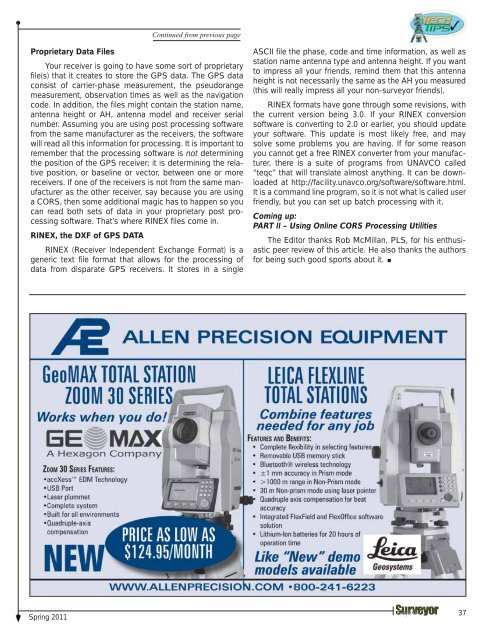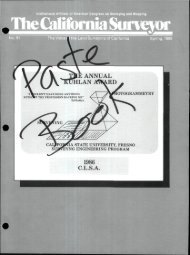Sacramento Surveyors Visit the NGS Airborne Gravimeter - CLSA
Sacramento Surveyors Visit the NGS Airborne Gravimeter - CLSA
Sacramento Surveyors Visit the NGS Airborne Gravimeter - CLSA
Create successful ePaper yourself
Turn your PDF publications into a flip-book with our unique Google optimized e-Paper software.
Continued from previous page<br />
Proprietary Data Files<br />
Your receiver is going to have some sort of proprietary<br />
file(s) that it creates to store <strong>the</strong> GPS data. The GPS data<br />
consist of carrier-phase measurement, <strong>the</strong> pseudorange<br />
measurement, observation times as well as <strong>the</strong> navigation<br />
code. In addition, <strong>the</strong> files might contain <strong>the</strong> station name,<br />
antenna height or AH, antenna model and receiver serial<br />
number. Assuming you are using post processing software<br />
from <strong>the</strong> same manufacturer as <strong>the</strong> receivers, <strong>the</strong> software<br />
will read all this information for processing. It is important to<br />
remember that <strong>the</strong> processing software is not determining<br />
<strong>the</strong> position of <strong>the</strong> GPS receiver; it is determining <strong>the</strong> relative<br />
position, or baseline or vector, between one or more<br />
receivers. If one of <strong>the</strong> receivers is not from <strong>the</strong> same manufacturer<br />
as <strong>the</strong> o<strong>the</strong>r receiver, say because you are using<br />
a CORS, <strong>the</strong>n some additional magic has to happen so you<br />
can read both sets of data in your proprietary post processing<br />
software. That’s where RINEX files come in.<br />
RINEX, <strong>the</strong> DXF of GPS DATA<br />
RINEX (Receiver Independent Exchange Format) is a<br />
generic text file format that allows for <strong>the</strong> processing of<br />
data from disparate GPS receivers. It stores in a single<br />
ASCII file <strong>the</strong> phase, code and time information, as well as<br />
station name antenna type and antenna height. If you want<br />
to impress all your friends, remind <strong>the</strong>m that this antenna<br />
height is not necessarily <strong>the</strong> same as <strong>the</strong> AH you measured<br />
(this will really impress all your non-surveyor friends).<br />
RINEX formats have gone through some revisions, with<br />
<strong>the</strong> current version being 3.0. If your RINEX conversion<br />
software is converting to 2.0 or earlier, you should update<br />
your software. This update is most likely free, and may<br />
solve some problems you are having. If for some reason<br />
you cannot get a free RINEX converter from your manufacturer,<br />
<strong>the</strong>re is a suite of programs from UNAVCO called<br />
“teqc” that will translate almost anything. It can be downloaded<br />
at http://facility.unavco.org/software/software.html.<br />
It is a command line program, so it is not what is called user<br />
friendly, but you can set up batch processing with it.<br />
Coming up:<br />
PART II – Using Online CORS Processing Utilities<br />
The Editor thanks Rob McMillan, PLS, for his enthusiastic<br />
peer review of this article. He also thanks <strong>the</strong> authors<br />
for being such good sports about it. <br />
Spring 2011<br />
37
















